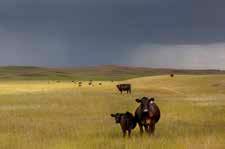GW CATTLEMEN’S COLLEGE
Nutritional Nonsense: Myths Debunked By Jake Renner
D
epending on the reader, I’m doing one of two things as I reference a TV show from my childhood. You’re either going to wonder what the heck I’m talking about and jump on YouTube to find out, or you’re reminiscing about the cool slow motion tapes, that poor mannequin getting tossed off of every high-rise building, or the iconic beret worn by Jamie Hyneman. You guessed it: I’m referring to MythBusters, and today we’re going to be the myth busters of cattle nutrition.
carcass weight of just over 620 pounds. That’s not to say that the 1,200-pound cow doesn’t still exist because she certainly does, but she’s just not the average. What does this mean for our cows nutritionally? For every 100 pounds of cow body weight, it requires 2.2 pounds Total Digestable Nutrients (TDN) or a half pound more protein. The notion that producers can’t manage what they don’t measure is extremely critical when it comes to cow body weight, according to Moore. Cow body weight varies by condition, stage of gestation, season and environment, etc. “We truly need to know body weight when it comes to economic precision from a nutrition standpoint and let’s not pretend that all of our cows weigh 1,200 pounds,” Moore said.
I was lucky enough to sit in on a presentation from Wesley Moore, Ph.D., beef technical specialist, Cargill Premix & Nutrition, and Dusty Abney, Ph.D., cowcalf nutritionist, Cargill Premix & Nutrition, at the Cattlemen’s College held during the 2020 Cattle Industry Convention and National Cattlemen’s Beef Association Trade Show in San Antonio, Texas, in February. Moore and Abney set out to debunk some of the most common myths they hear in the world of cattle nutrition.
Myth: All my cows weigh 1,200 pounds! Trends show over the past 40 years that the industry isn’t raising its grandads’ or dads’ cows any longer. Sure, producers may be using the same land, facilities, and tractor, but with the improvements made to genetics over the past four decades along with feed efficiency and proper land utilization, cows are surpassing the 1,200 pound mark grandpa/dad used to raise in the ‘70s. The amount of beef produced per cow has seen an 18% increase over the past 20 years. According to National Agricultural Statistics Service, carcass and live cow weight trends have increased substantially in the last 40+ years, as seen in Table 1, from the presentation. In 1974 live cow weights were averaging just over 1,000 pounds with a carcass weight average of 500 pounds. Jump to 2018 and both numbers have grown to support the notion that we are no longer raising our grandads’ cows in the twenty-first century. Instead, an industry average live weight is estimated at just under 1,400 pounds with a
22 | APRIL 2020
Table 1.
Myth: I can’t afford to feed those cows! It may sound elementary, but the truth is that accurate body condition scoring (BCS) is a huge part of ensuring that our cows get bred. Can you breed a cow at BCS 3 or 4? The answer: eventually. If a breeding opportunity is missed, and yes, a low BCS can play a big factor in her cycle, that calf is 21 days younger, at 2 pounds a day on his/her dam’s side that’s 42 pounds lighter than he/she should be. In today’s market, that equates to $50 to $60 out of a producer’s pocket all because of a missed a breeding opportunity, according to Abney. Fetal programming: What happens to the cow during pregnancy does have lifelong implications for the calf that affect the operation’s bottom line. If the goal is to keep heifer calves as replacement heifers, a cow that was bred at a BCS 5-6 on the first cycle calves earlier and will likely breed back earlier (if nutritional




